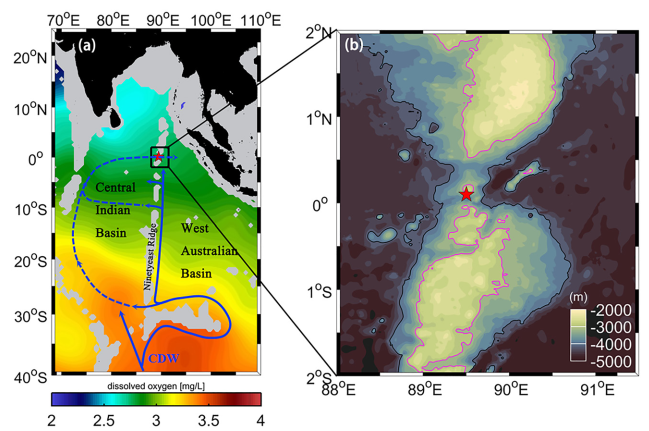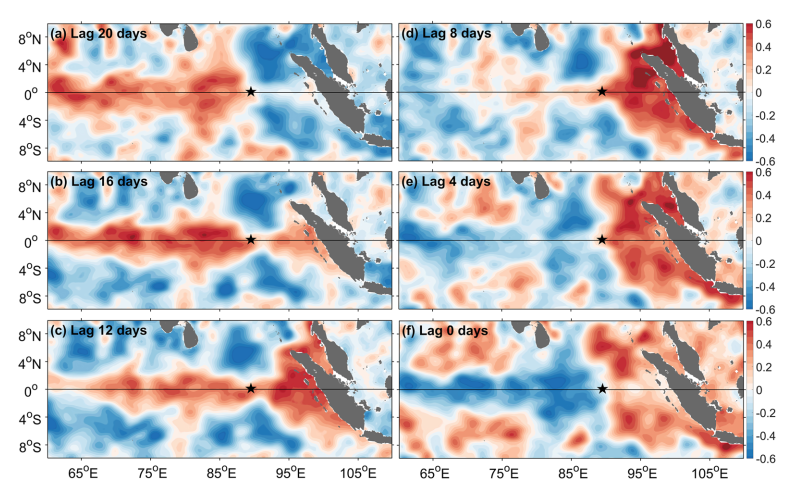Program
Recently, assistant researcher Ye Ruijie of the team led by Zhou Feng, a researcher in the field of offshore dynamics and ecological environment from the SIO, and the co-authors published the research results entitled “Energetic Bottom Current at the Equatorial Gap of the Ninety East Ridge in the Indian Ocean Based on Mooring Data” on the famous journal of Journal of Geophysical Research: Oceans under the American Geophysical Union. Based on the long-term continuous observation data of the bottom mooring buoy obtained by the JAMES project, this paper reveals the temporal variation characteristics of the bottom current at the equatorial gap of the Ninety East Ridge in the Indian Ocean, and deeply probes the relationship between the intraseasonal variability of the bottom current and the upper ocean dynamic process. The co-authors include researcher Zhou Feng (corresponding author), assistant researcher Ma Xiao, senior engineer Zhou Beifeng, engineer Zeng Dingyong, associate researcher Meng Qicheng, associate researcher Lin Feilong, associate researcher Xu Mingquan from the Laboratory of the SIO, and associate researcher Liu Chenggang, researcher Li Hongliang, profession level senior engineer Shou Lu from the Key Laboratory of Marine Ecosystem Dynamics, MNR.
Large-scale ocean overturning circulation plays an important role in global ocean material and energy transport, carbon cycle and climate regulation. Deep ocean flow is a vital component of the deep branch of large-scale ocean overturning circulation, and is a key link to study global climate regulation by large-scale ocean overturning circulation. However, due to the limitation of observation technology and cost, the field observation data of deep ocean is very scarce, especially in the area near the bottom of complex terrain. The Ninety East Ridge is located in the East Indian Ocean, separating the East Indian Ocean into the Central Indian Basin and the West Australian Basin, which exchange deep water through several major gaps of the Ninety East Ridge (Figure 1). At present, most of the studies on the deep flow at the gap of the Ninety East Ridge are based on short-term field observation and mode diagnosis, and cannot truly reflect the temporal variation characteristics of the bottom current at the gap of the Ninety East Ridge, resulting in significant uncertainty in previous estimates of water exchange flow. By continuously observing for a long time, the temporal variation characteristics of the bottom current can be effectively obtained. This study provides an observational basis for further study of the deep water exchange in the Central Indian Basin and the West Australian Basin and the temporal-spatial structure of the overturning circulation in the East Indian Ocean.

Figure 1 (a) Buoy observation station. (b) Terrain near the observation station.
According to the bottom mooring observations at the equatorial gap of the Ninety East Ridge in the Indian Ocean, a strong westward bottom current was found at this position. The observed bottom current has significant intraseasonal variability (ISV) with a dominant time scale of ~33 days, which becomes enhanced in summer and winter. Affected by monsoon, there are abundant intraseasonal oscillation signals in the upper ocean of the equatorial area of East Indian Ocean. Based on sea surface height data, it is found that the ISV of the bottom current at the equatorial gap of the Ninety East Ridge is closely related to the upper ocean dynamics process (Figure 2). Forced by ocean surface wind, Kelvin waves on the upper ocean of the equatorial area of East Indian Ocean are generated and propagated eastward, and reflected at the eastern boundary to generate Rossby waves propagated westward. Based on the model data from the Copernicus Marine Environment Observation Service, this study reveals that the westward propagation of Rossby waves generated at the eastern boundary of the East Indian Ocean can propagate the upper ocean intraseasonal oscillation signal to the deep ocean, thereby causing the enhancement of the intraseasonal oscillation signal of the bottom current at the equatorial gap of the Ninety East Ridge (Figure 3).
This research is one of the important research achievements of the National Major Project - “Global Change and Air-Sea Interaction (Phase II)” of the Ministry of Natural Resources. Under the support of this special project, the SIO led and initiated the “Joint Advanced Marine and Ecological Studies” (JAMES), and the cooperation units include domestic business and R&D institutions such as the National Marine Environmental Forecasting Center and the National Ocean Technology Center, as well as universities or ministries from countries such as Sri Lanka, Myanmar and Thailand. This project aims to study the ecological environment characteristics of the equatorial East Indian Ocean and the Bay of Bengal and their response to monsoon, climate and human activities, and jointly implement the vision of the Belt and Road and the construction of the maritime community of shared future with countries along the Maritime Silk Road.

Figure 2 Correlation between bottom zonal current velocity and sea surface height at the equatorial gap of the Ninety East Ridge in the Indian Ocean

Figure 3 Propagation path of the intraseasonal oscillation signal of the zonal current in the equatorial section, the east-propagating Kelvin wave (blue solid line) and the west-propagating Rossby wave (black dashed line) reflected at the eastern boundary
Paper Citation:
Ye, R., Zhou, F., Ma, X., Zhou, B., Zeng, D., Liu, C., Meng, Q., Lin, F., Xu, M., Li, H., & Shou, L. (2023). Energetic Bottom Current at the Equatorial Gap of the Ninety East Ridge in the Indian Ocean Based on Mooring Data. Journal of Geophysical Research: Oceans, 128(3), e2022JC018974. https://doi.org/10.1029/2022JC018974



